Unveiling the Editing Process of Japanese Demons Picture Scrolls: How Digital Humanities Played a Role in Developing a New Theory in Art History
1. Introduction
Digital humanities have promoted the digitization, sharing, and visualization of humanities resources. However, as Flanders, Piez and Terras stated in the first issue of Digital Humanities Quarterly , digital humanities “is by its nature a hybrid domain, crossing disciplinary boundaries and also traditional barriers between theory and practice, technological implementation and scholarly reflection” 1.
Digital humanities is an ongoing effort to facilitate interaction between traditional humanities and digital/computational methods. However, continuing this effort is somewhat challenging. The main obstacles are difficulties in understanding each other’s languages and methodologies. To promote interaction with humanities scholars, the digital humanities side should demonstrate how their methods can contribute to specific humanities research topics. Similarly, humanities scholars should expand their knowledge of digital/computational approaches. What is needed is not sophisticated tools or presentations but concrete results that address unsolved questions.
Flanders argues that humanities computing does not primarily concern itself with either the discovery of new knowledge or the validation of existing information. Instead, she suggests that its core function lies in the modeling of that knowledge, and in certain instances, the modeling of the modeling process itself. According to her, humanities computing is a method of exploring our modes of knowledge acquisition and the presentation of that knowledge for personal study 2. Going beyond Flanders’s argument, this paper aims to model how we comprehend a type of artwork using a mixed quantitative and qualitative methodology, and furthermore discover new knowledge in the field of Japanese art history from a digital humanities perspective.
New discoveries through digital humanities approaches are still forthcoming. Regarding the knowledge discovery in art history by computer vision technology, Lang and Ommer discussed effective use cases of digital technology, which include a classification and visualization of age and social status of models in painted portraits. They conveyed the idea that it is not enough to just convert analog methods into digital ones, as this approach does not capture the unique attributes and potential of digital data. They emphasized that the generation of new knowledge only becomes possible when we devise new computational methods for handling digital data. This level of knowledge production, they argue, could not be achieved with analog data and its corresponding methods. The impact of this shift, they stressed, extends beyond art historians to also touch earlier generations of academics, particularly students 3.
The use of digital methods, nonetheless, should be judiciously applied to facilitate seamless communication between scholars in humanities and digital humanities. An effective stragegy is to pursue a study on a topic that is not overly specialized, thereby eliciting broader interest and utilizing a language mutually comprehensible to each other. In order to meet these criteria, this paper undertakes an examination of well-known artworks in Japan, utilizing digital methods that are not excessively complex.
2. Mysteries Surrounding the “Night Parade of One Hundred Demons” Picture Scrolls
“ Hyakki Yagyō (Yakō) Emaki ” 4 ( “Night Parade of One Hundred Demons” Picture Scroll; henceforth, Demons Scroll), which depicts yōkai (Japanese specters) marching at midnight, have been popular in Japan due to the enigmatic and humorous depictions of demons.5 It is believed that numerous Japanese painters replicated this subject between the sixteenth and nineteenth centuries, resulting in the formation of several lineages of “ Hyakki Yagyō ” scrolls.6 The creation of multiple copies of these scrolls is indicative of a significant copy culture in premodern Japanese art.7
Shinjuan, a sub-temple of Daitokuji temple in Kyoto, owns the most famous version of the Demons Scroll, attributed to Tosa Mitsunobu8 (1434–1525) and designated as an important cultural property of Japan (Figure 1). The majority of research on Demons Scrolls has referenced this Shinjuan copy. Since the Shinjuan scroll is believed to be the oldest of the known Demons Scrolls, it is only natural that scholars have focused their attention on it. However, previous research has overlooked an important fact: although many copies depict the same demons as the Shinjuan painting, few scrolls have the same compositional arrangement.9 If the Shinjuan scroll is the oldest Demons Scroll, then many more copies with the exact same arrangement should be preserved. The demon arrangement in the Shinjuan scroll is likely one of many variants of the Shinjuan lineage of Demons Scrolls. It is also possible that the configuration of demons in the Shinjuan scroll’s prototype differed from the extant copy.
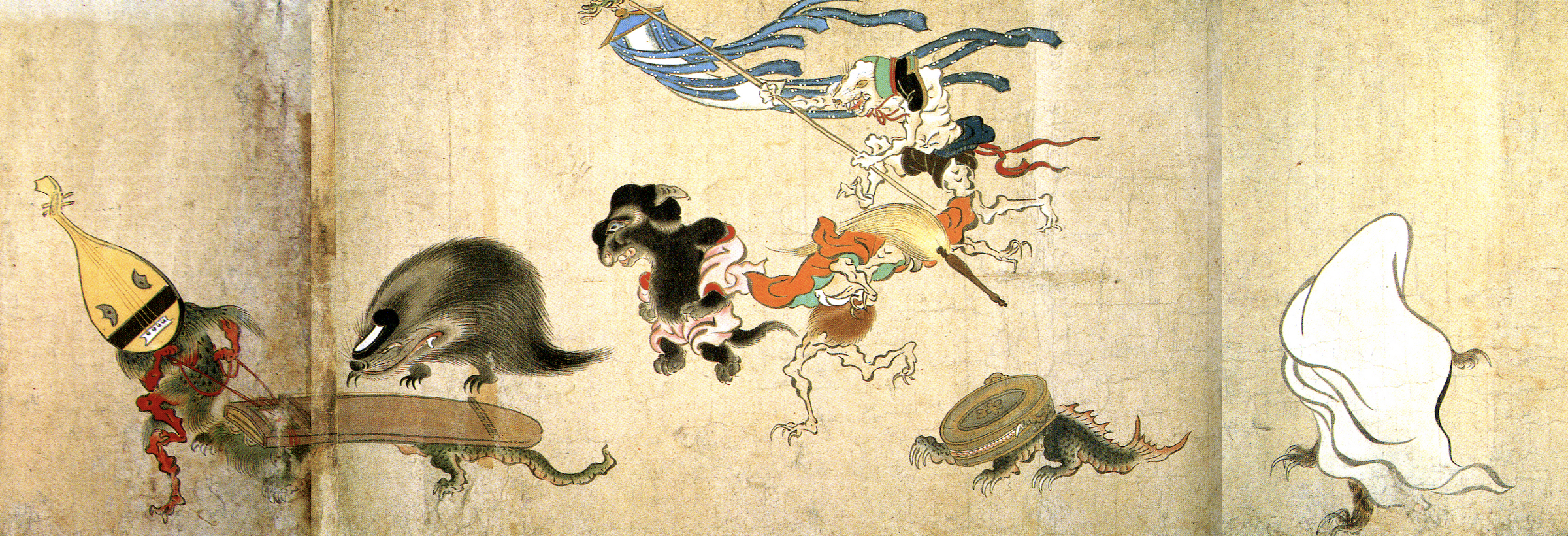
Detail of the Shinjuan scroll (viewed from right to left). The size of the entire scroll is 33x735 cm [^tanaka1999].
Researchers of the Demons Scrolls have noted the need to reevaluate the Shinjuan scroll’s significance. Tanaka Takako, a scholar of Japanese medieval literature, stated, “The Shinjuan copy was likely not the prototype of the Demons Scroll, but rather a unique case. In other words, among the numerous Demons Scrolls that circulated between the sixteenth and nineteenth centuries, I believe the Shinjuan lineage was fortuitously propagated” 10. Yumoto Kōichi, a collector and researcher of materials pertaining to Japanese specters, wrote, “If the Shinjuan lineage is the standard, other copies omitted certain demons and added new ones. To position the Shinjuan version, its relationship with other types of Demons Scrolls must be clarified” 11. In response to these studies, the Japanese expert on specter culture Komatsu Kazuhiko stated, “When considering the lineage of Demons Scrolls, we must set the Shinjuan copy aside” 12. Based on their perceptions, this paper will present a new theory regarding the Shinjuan scroll.
In addition to the Shinjuan lineage, there are several other variants with different demons and what appears to be a mixture of two lineages. Tanaka centered her attention on a copy known as the “ Tōhaku mohon ” (in this paper, the Tōhaku-A scroll). The Tōhaku-A scroll contains all of the demons depicted in the Shinjuan scroll, as well as a large number of additional demons. Tanaka presumed that the original Tōhaku-A lineage predates the Shinjuan lineage and that the latter is an idiosyncratic copy of the Tōhaku-A lineage created by extracting demons from it.
In 2007, the “ Hyakki no zu ” ( “Picture of One Hundred Demons” ) picture scroll acquired by the International Research Center for Japanese Studies ( “ Nichibunken ” ; in this paper, Nichibunken-A scroll) was discovered to be composed of demons from the Tōhaku-A lineage minus those from the Shinjuan scroll. Komatsu’s investigation of the Nichibunken-A scroll led him to conclude that its prototype dates to the sixteenth century, the same era during which the Shinjuan version is believed to have been painted. Komatsu argued that, contrary to Tanaka’s theory, the original Tōhaku-A was a combination of the Shinjuan and Nichibunken-A compositions. Moreover, Komatsu asserted that Demons Scrolls can be classified into four distinct lineages that do not overlap, and that these lineages were sometimes combined to produce a variety of copies. The four lineages are represented by the Shinjuan, Nichibunken-A, Kyoto City University of the Arts (KCUA), and Hyogo Prefecture Museum of History (Hyogo-A) scrolls 12.
The study by Komatsu was the first to investigate and classify sixty-four known Demons Scrolls, including those preserved in the United States and Europe. By examining a diversity of scrolls, Komatsu was able to clarify that there are combined copies of Shinjuan and Nichibunken-A; Shinjuan and KCUA; Shinjuan and Hyogo-A; and Nichibunken-A and KCUA. If we were to accept Tanaka’s theory that the Shinjuan scroll is an idiosyncratic copy, we would have to recognize that demons in Tōhaku-A were neatly separated to form the Shinjuan and Nichibunken-A lineages, with no overlap. However, this is unlikely. In contrast to Tanaka’s theory, Komatsu’s mixture theory seems more plausible. The author agrees with the mixture theory positing that there are four distinct lineages of Demons Scrolls: Shinjuan, Nichibunken-A, KCUA, and Hyogo-A, and that these were intermixed to produce the Tōhaku-A scroll and other combined copies. However, previous studies, including those by Komatsu, have focused on the differences and interpretations of the images while ignoring the arrangement of the demons. Using the digitized photographs of scrolls that Komatsu collected and others that have recently been made available on the internet, it is possible to estimate the process by which Demons Scrolls were drawn and edited by successive generations of painters.
Utilizing a computational method, this paper will explore new approaches to this research topic. The author will not employ aesthetic criteria, such as line quality. Deliberately disregarding minor differences in depiction, the author will identify the demons based on the parade’s sequential order. Similar to a DNA test, we will calculate the proximity between two scrolls and try to determine the genealogy of Demons Scrolls.
3. Estimation Model for the Picture Scroll Editing Process
Several previous studies have examined the editorial process of Japanese cultural artifacts. Yano Tamaki has conducted research on the genealogy of esoteric texts on the tea ceremony (chadō) 13 14, as well as the “ Sanjūrokkasen Emaki ” ( “Picture Scroll of Thirty-Six Master Poets” ) 15, using tools such as SpritsTree16 and Hayashi’s Quantification Theory Family III.17 Nevertheless, these studies rely on textual arrangement, including those that focus on illustrated scrolls. There is a conspicuous lack of previous research that examines the genealogy of picture scrolls based on their visual representations.
To ascertain the picture scroll editing process, we propose the following estimation model: the fewer the differences between scrolls, the shorter the number of edits between them, and the closer they are to each other in the chain of copying. For instance, if one block differs between scrolls A and B, and between B and C, and two blocks differ between scrolls A and C, the most likely conclusion is that B was created by editing A, and C was created by editing B (or vice versa). Obviously, one cannot rule out the possibility that C was created by editing A without mediating B, but this is probably not the case.
This paper utilizes the concept of edit distance in order to quantify the differences between scrolls. Edit distance is a standard method for determining text similarity 18.19 In recent years, the field of linguistic computing has developed a variety of applications for edit distance, such as historical name normalization 20 21, text comparison 22 23, and analysis of library catalog transmission 24. Its application to visual arts, however, is somewhat challenging because edit distance is rarely applied to non-textual data.
Typically, edit distance is calculated based on the number of edit operations per symbol, but to accommodate this application to Demons Scrolls, we will use symbol blocks (chunks of symbols) as the unit and count the numbers of swap, insertion, and deletion operations on the blocks. This estimation model differs from Levenshtein distance (including insertion, deletion, and substitution) and Damelau-Levenshtein distance (Levenshtein plus transposition of two adjacent characters). We will assume that the differences between the symbol arrays 123456789 (sequence-A), 145678239 (sequence-B), and 167845239 (sequence-C) are due to editing operations. The estimated editing procedure is described in Figure 2. The symbol block 23 in sequence-A first swaps with 45678, then it turns into sequence-B. Next, the symbol block 45 in sequence-B swaps with 678, then it becomes sequence-C. The edit distance between A and B (and also between B and C) is one, while the edit distance between A and C is two. In this example, it is plausible that the sequence-A is edited into sequence-B, which is then edited into sequence-C (or vice versa). This estimation model is incapable of determining a single conclusion; it can only indicate what are the plausible processes. Therefore, it is essential to confirm the estimation’s accuracy by employing additional qualitative methods.
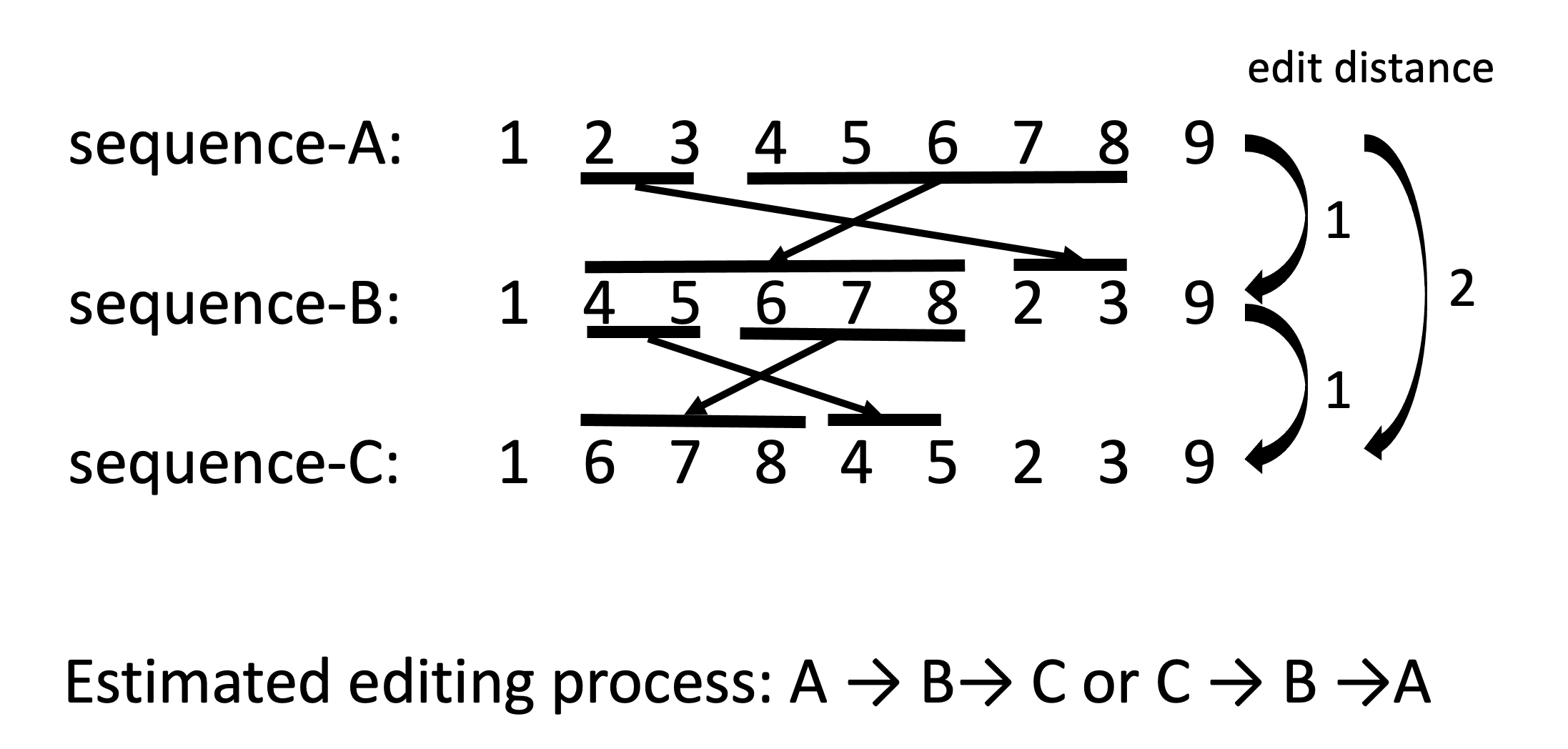
Estimation model of editing process using edit distance of symbol sequences.
This estimation model posits that picture scrolls can be segmented and encoded. By identifying the individual demons depicted in a Demons Scroll, it is possible to create symbol blocks and segment the scroll. However, this estimation model is challenging to apply when parts of a scroll are missing or if the consecutively joined sheets of paper have become disordered.25
4. Works for Discussion
This paper will analyze seventy-one Demons Scrolls, which include the sixty-four works catalogued by Komatsu 12. We excluded works that were evidently copied after the mid-nineteenth century, and limited our study to the previously mentioned four lineages, as well as works constituting mixed editions of them. Komatsu classified the lineages as follows: class-A (Shinjuan lineage), class-B (Nichibunken-A lineage), class-C (KCUA lineage), and class-D (Hyogo-A lineage).26 In addition, he discovered four types of mixed copies, including class-AB (Shinjuan+Nichibunken-A), class-AC (Shinjuan+KCUA), class-AD (Shinjuan+Hyogo-A), and class-BC (Nichibunken-A+KCUA). However, a closer look at these scrolls reveals that Komatsu’s class-AB can be divided further into two classes: class-AB (the Shinjuan scroll demons come first, followed by the Nichibunken-A parade of demons) and class-BA (the demons in the Nichibunken-A scroll come first, followed by those in the Shinjuan scroll). Class-AD can also be divided into AD and DA. Our revised list of works is presented in the Appendix in light of these findings.
As stated at the end of section 2, we identified the demons by focusing on their relative positions in the parade sequence as opposed to minute differences in their depictions. Similar demons appearing in a similar sequence in two scrolls are deemed identical, and the two arrangements are thought to be the same (Figure 3). This method is not applicable to picture scrolls with a strong suspicion of missing or disordered sheets of paper, or to folding screens and hanging scrolls. Therefore, such materials were excluded from the analysis. The target works are consequently limited, as shown in the Appendix. We should note that one of the target works (Kyōgaen in class-AC) is a woodblock-printed book and not a painted scroll. We decided to include it because the demons in the book are depicted in sequential order and it contains useful information such as the date of publication.
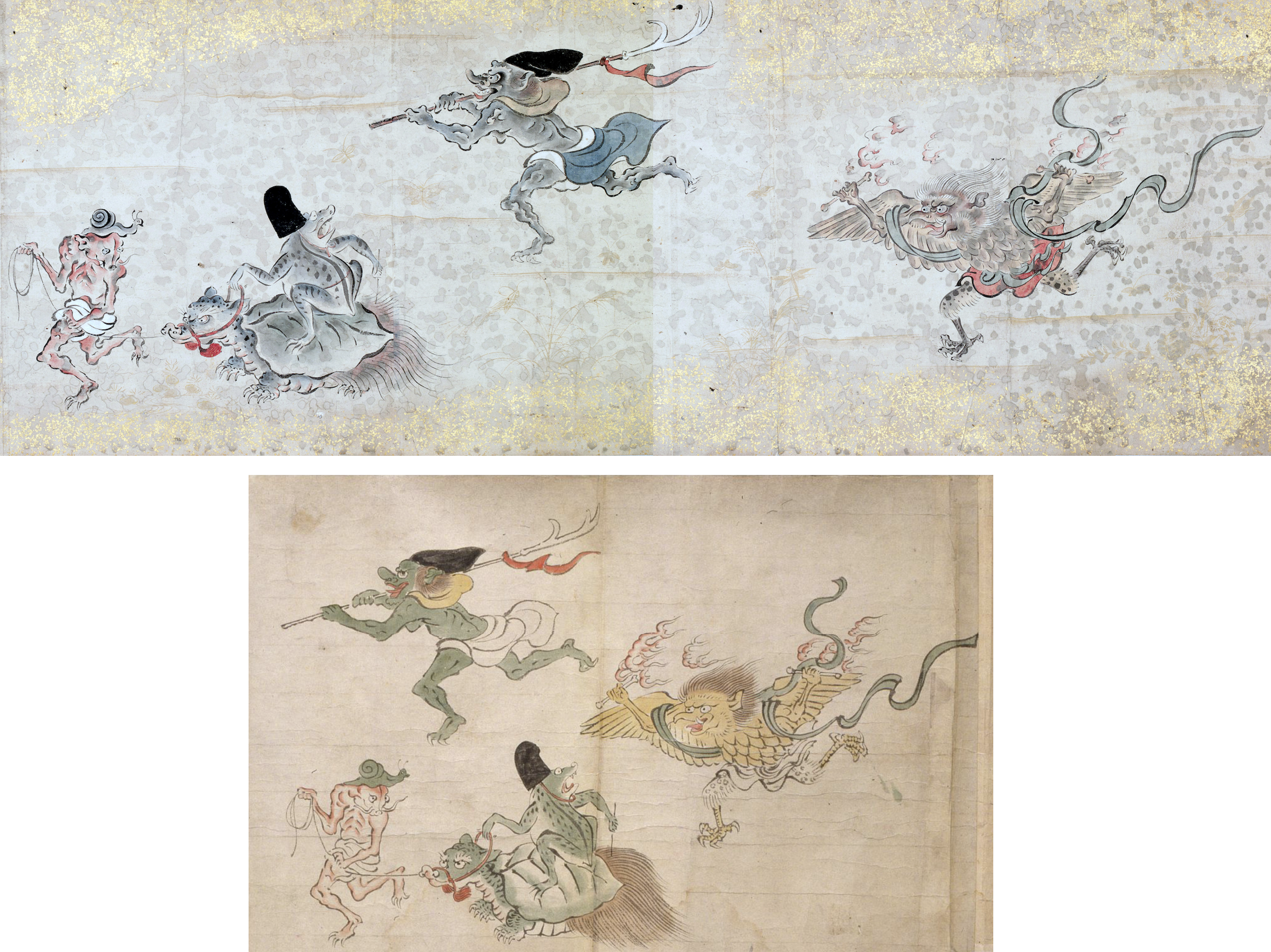
A case where two arrangements are regarded as identical, considering the adjacent demons (upper: Nichibunken-A, lower: Geidai-A).
5.1 Genealogy of the Shinjuan Lineage
Based on the arrangement of demons, we will first attempt to estimate the editing process of the Shinjuan (class-A) lineage, the most popular lineage of Demons Scrolls. As depicted in Figure 4, we identified all the demons in the Shinjuan scroll and assigned numbers to them. Using these numbers, eight other class-A scrolls were converted into symbol sequences. The Shinjuan (No. 1 in Appendix), Itō (No. 7), Iwate (No. 9), NDL-A (No. 12), Nichibunken-B (No. 14), Nichibunken-C (No. 15), Rekihaku-A (No. 18), Rikkyo (No. 21), and Spencer-B (No. 23) are the nine scrolls examined here that show almost the same numbers of demons in comparison to the Shinjuan scroll (Figure 5). In the case of the Shinjuan and Rekihaku-A scrolls, for instance, if we swap two blocks of demons in Shinjuan, (No. 04−07 with 08−30, and No. 20−30 with 31−43 in Figure 4) the demons transform into the arrangement in Rekihaku-A. The edit distance between the two scrolls is therefore two (See Figure 6).
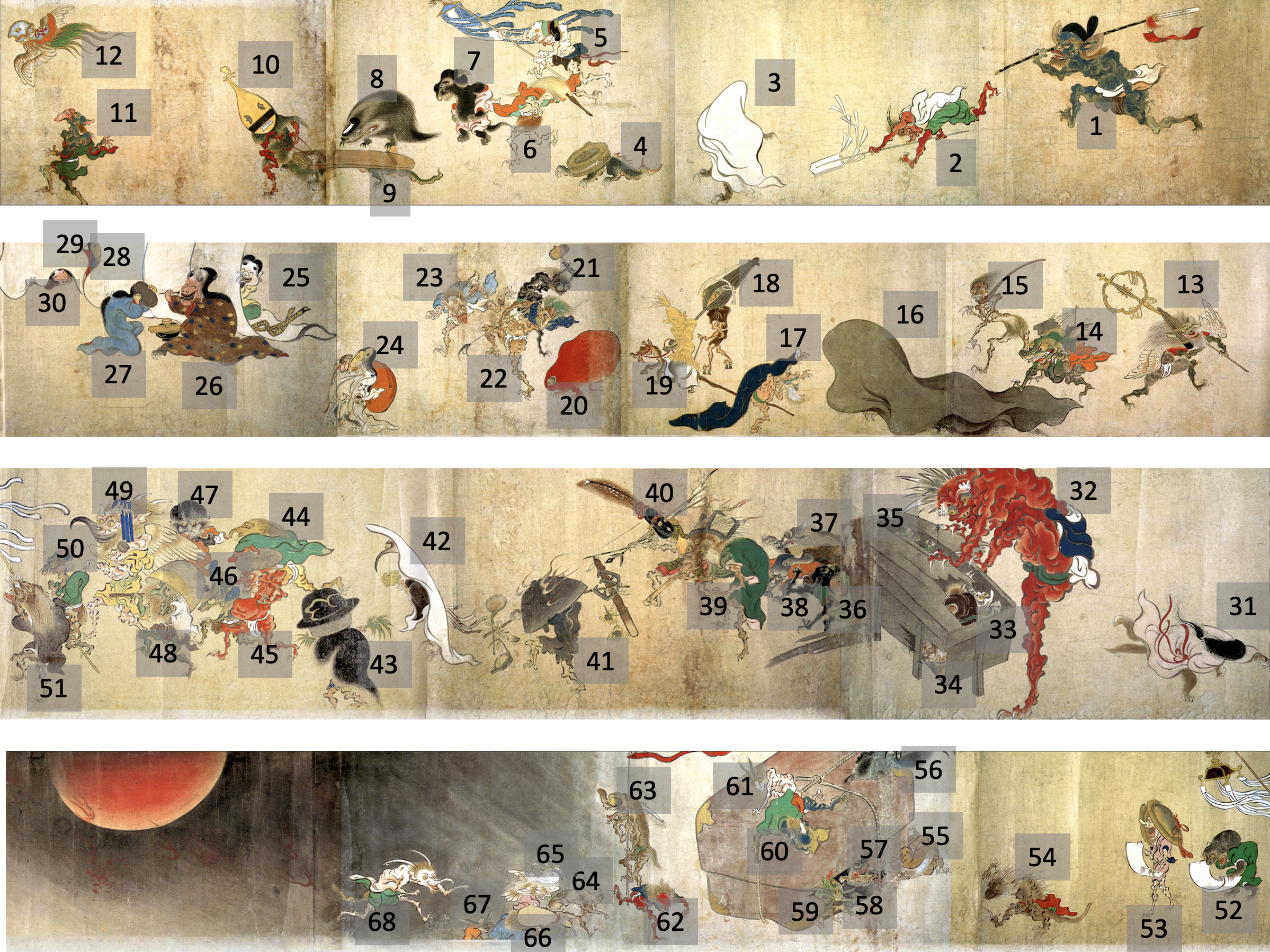
Numbering the demons in the Shinjuan scroll. The scroll is viewed from upper-right to lower-left [^tanaka1999].
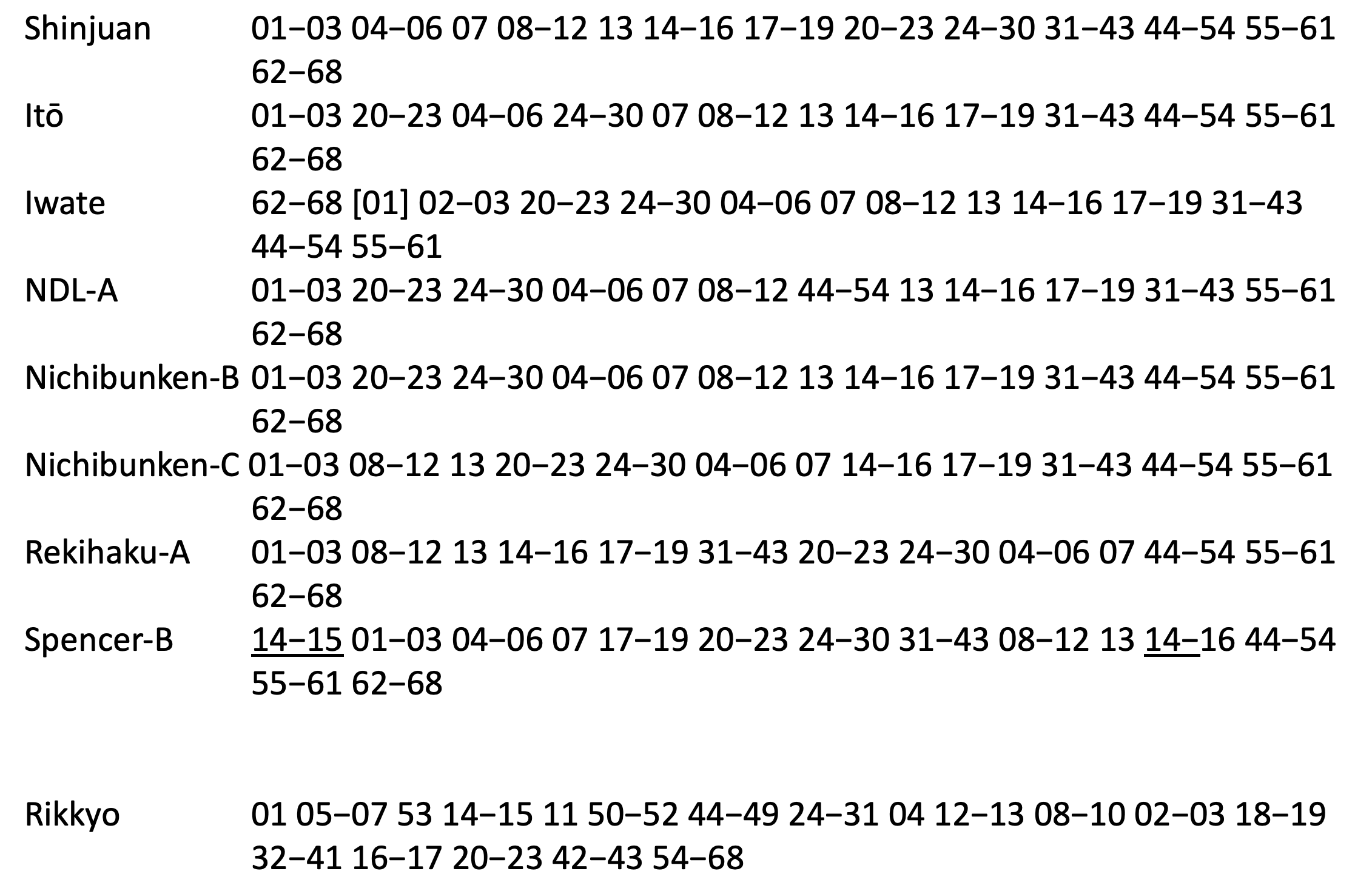
Demons in the Shinjuan scroll are sequentially numbered from the beginning (right edge of the scroll) to the end (left edge). The hyphenated numbers are the common blocks in eight scrolls excepting Rikkyo. The numbers that are underlined or in square brackets indicate the duplication and the omission of a demon, respectively. The Rikkyo scroll is separated from the discussion because of its unique arrangement.
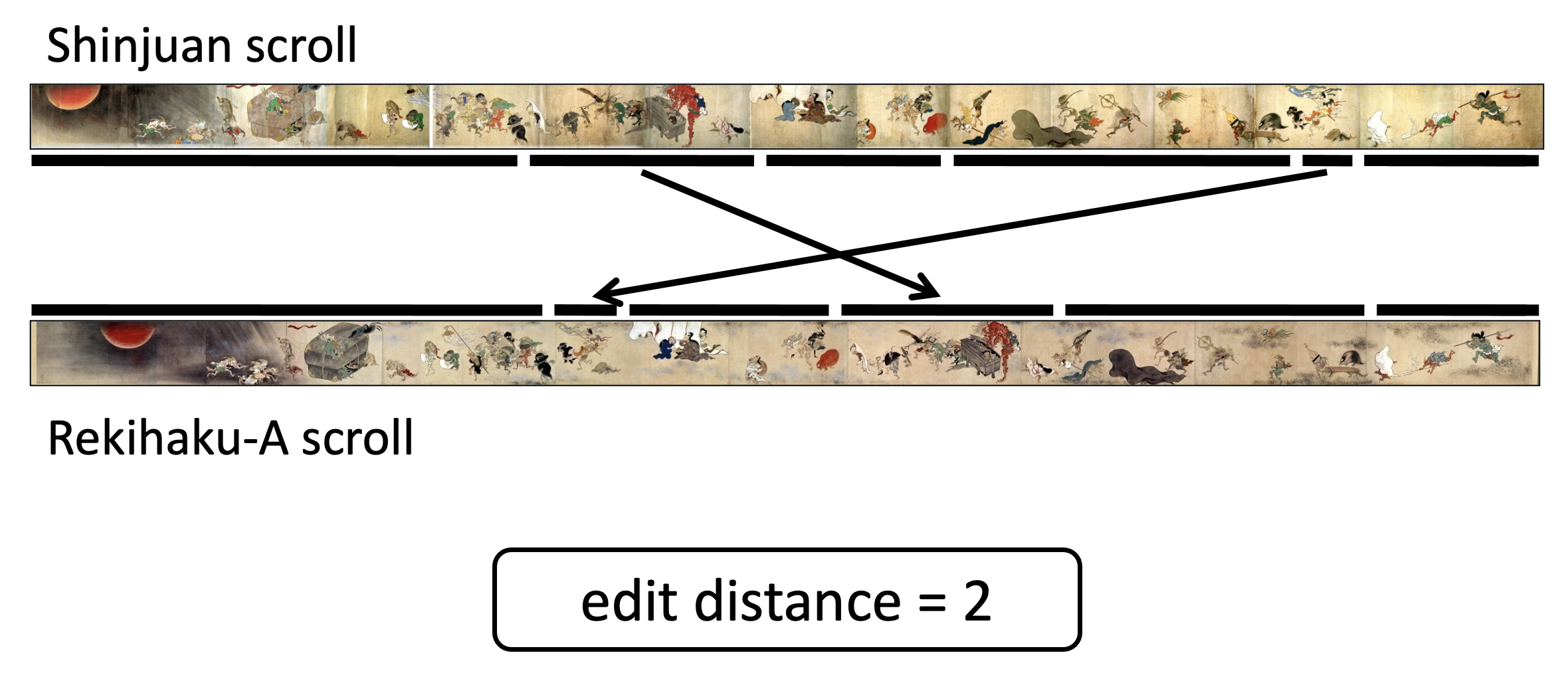
Edit distance between two scrolls. The scrolls are viewed from right to left.
Of these nine scrolls, we omitted the Rikkyo scroll because of its evidently unique arrangement. It has an unusual layout compared to other scrolls and can be considered an atypical copy. The edit distances between eight of the scrolls are shown in Table 1. Among them, the arrangement of Nichibunken-B is particularly notable (Yumoto-A [No. 26 in the Appendix] has the same arrangement).27 This copy is connected to five scrolls (Shinjuan, Itō, NDL-A, Nichibunken-C, and Rekihaku-A) via an edit distance of one.
Edit distance between eight Shinjuan (class-A) lineage scrolls. The lower left section of the table is omitted because the numbers are identical to those in the upper right section. Shinjuan Itō Iwate NDL-A Nichibunken-B Nichibunken-C Rekihaku-A Spencer-B Shinjuan 0 2 3 2 1 2 2 2 Itō 0 3 2 1 2 2 4 Iwate 0 3 2 3 3 5 NDL-A 0 1 2 2 4 Nichibunken-B 0 1 1 3 Nichibunken-C 0 1 4 Rekihaku-A 0 4 Spencer-B 0
Based on the matrix of edit distance, multiple possible lineage trees can be drawn. The simplest tree is a structure where the sum of the distances is minimized, or the minimum spanning tree, as depicted in Figure 7. Nichibunken-B (Yumoto-A), which is located at the root and has the shortest distance to other scrolls, is connected to the Itō, NDL-A, Nichibunken-C, Rekihaku-A, and Shinjuan scrolls at a distance of one, and to the Iwate scroll at a distance of two. Spencer-B is connected at two to the Shinjuan scroll, while Rikkyo is isolated. If the class-A lineage shares a common ancestor, this tree indicates that the Nichibunken-B scroll’s demon arrangement is the closest to it. In other words, it is possible that the Shinjuan scroll is a rearranged version of Nichibunken-B’s prototype.
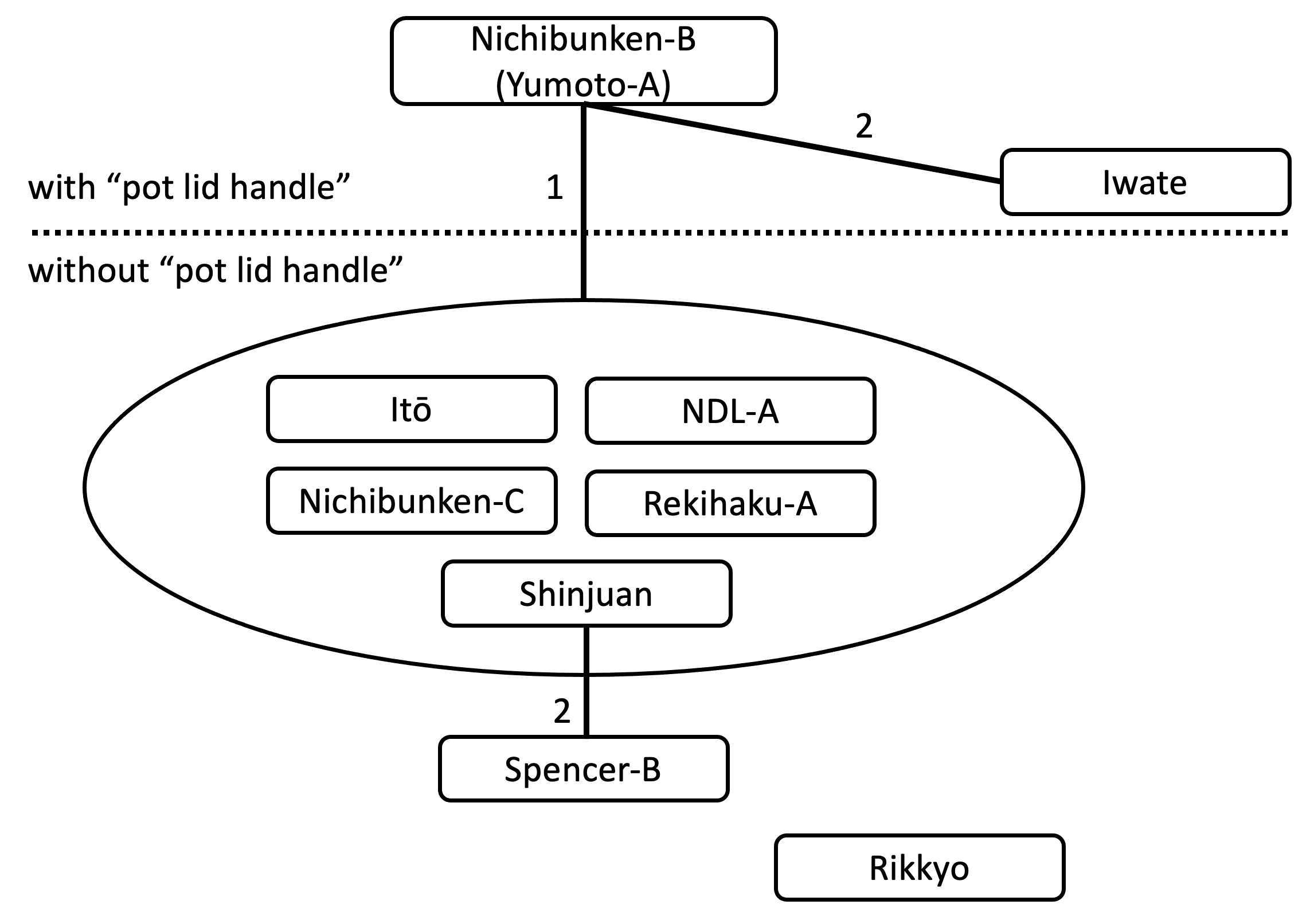
The minimum spanning tree of class-A scrolls.
This lineage tree is supported by a comparison of iconographic details. For example, let us investigate whether or not a handle is depicted on the pot lid of the demon wearing a pot lid that appears in the latter half of class-A lineage scrolls (Figure 8). Japanese art historian Komatsu Shigemi observed that the handle depicted in the Tōhaku-A (No. 49 in the Appendix) scroll was missing in the Shinjuan scroll. He stated that “such detailed copying strongly suggests that the Shinjuan scroll was painted based on a prototype” and that the Shinjuan scroll had another prototype 28. If we apply the presence or absence of the pot lid handle to the lineage tree depicted in Figure 7, we find that the handle is depicted in Nichibunken-B (Yumoto-A), which is at the root, and in the Iwate version, but not in other scrolls. This indicates that the presence of the handle was clearly distinguished on the lineage tree. While Nichibunken-B (Yumoto-A) retains the demon arrangement of the ancestorial copy relatively well, the Shinjuan and other six scrolls are copies of versions in which the pot lid handle was omitted.
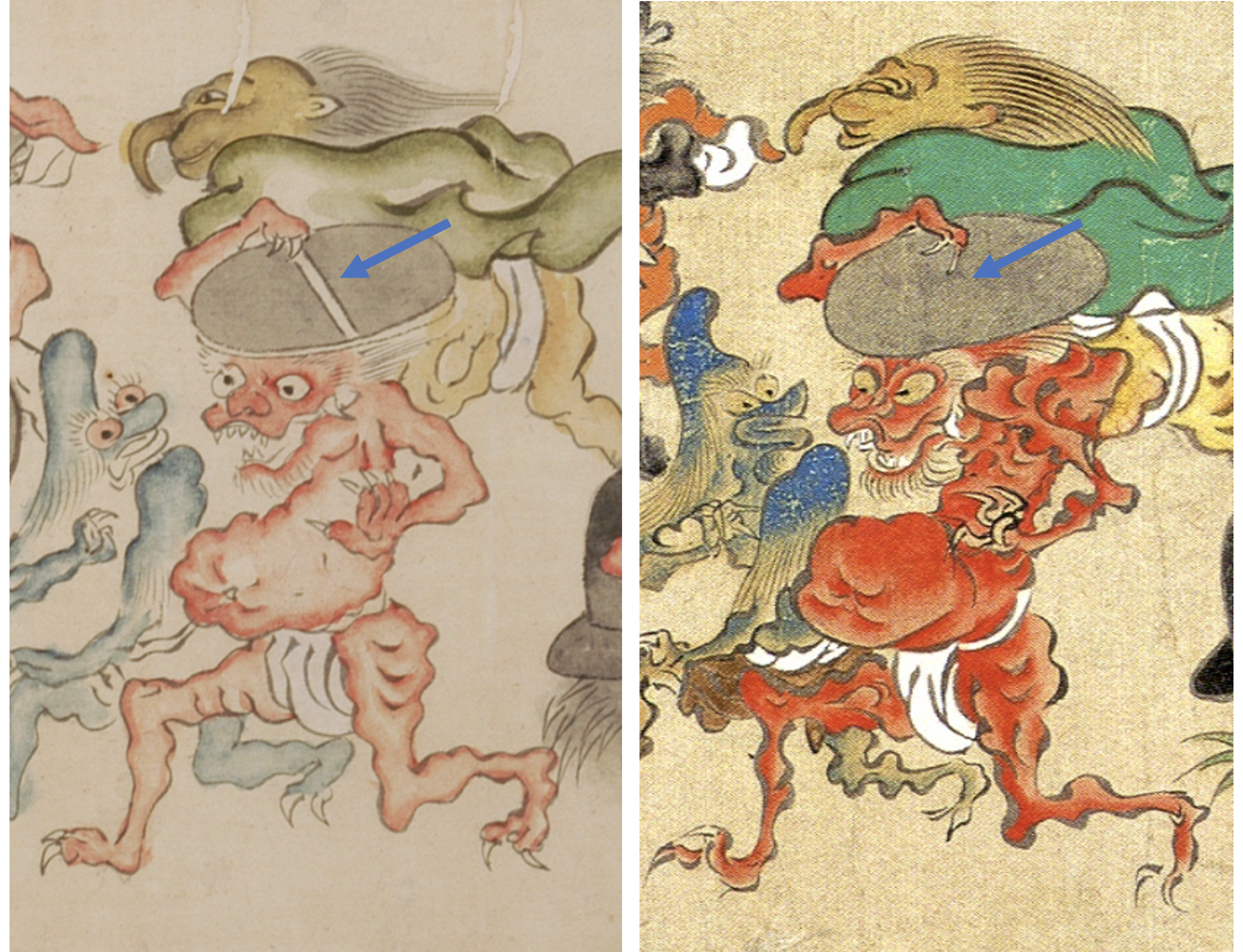
With and without pot lid handle (left: Nichibunken-B scroll, right: Shinjuan scroll).
In what ways do the demon configurations of the Nichibunken-B and Shinjuan scrolls differ? As illustrated in Figure 9, the two can be transformed by a single block swap. It is remarkable that some of the movable demon blocks in the Shinjuan scroll can be separated at the paper joins. Five joins in this scroll do not overlap the figures, and three of them are the boundaries where the demons are arranged differently than in Nichibunken-B. In contrast, only one join at the beginning of the Nichibunken-B scroll does not overlap the figure. In other words, the arrangement of the demons in the Shinjuan scroll can be transformed to that of Nichibunken-B by simply detaching the paper joins and rearranging the sheets. If the arrangement of Nichibunken-B is closer to the Shinjuan scroll’s prototype, we can conclude that the order of paper sheets became disordered during a remounting and resulted in the current arrangement in the Shinjuan scroll. This new theory regarding Demons Scrolls emerged from the field of digital humanities. Close inspection reveals that the Shinjuan scroll’s joined sheets of paper are stained along their edges. This indicates that the sheets of papers were separated and preserved for a certain period of time, and is evidence supporting our conclusion that the sheets were incorrectly arranged when the scroll was reassembled.

Differences in the arrangement of demons in the Nichibunken-B and Shinjuan scrolls (viewed right to left). Up arrows indicate the places where the paper sheets are joined and the figures do not overlap.
5.2 Iconographical Interpretation Through Numbering
Because the majority of Demons Scrolls lack the names and descriptions of each demon, it is difficult to comprehend their iconographic meanings. Nonetheless, by numbering the demons, we are able to see how the individual demons collectively form meaningful units. If a block of demons appears in multiple copies, it indicates that it was recognized as a unit by multiple painters.
Researchers of Demons Scrolls have debated the iconography of No. 31 (running fox lady) in Figure 10: whether she is running toward the group of ugly women with black teeth29 in front of her (No. 24−30) 30 11, or escaping from the cloud of demons that follows (No. 32−) 31 12. An examination of Figure 5 reveals that six scrolls (Itō, Iwate, NDL-A, Nichibunken-B, Nichibunken-C, and Rekihaku-A) contain the common separation of the block between No. 30 and 31. While it is impossible to determine the intentions of the original painter of the class-A lineage, this separation suggests that many painters who copied the scroll may have interpreted the running fox lady as escaping from the cloud of demons. This is another new theory developed through digital humanities. As previously discussed, misordering of the sheets of paper is suspected between section No. 30 and 31 in the Shinjuan scroll. In other words, the original compositional arrangement would also have intended the fox lady to be escaping.
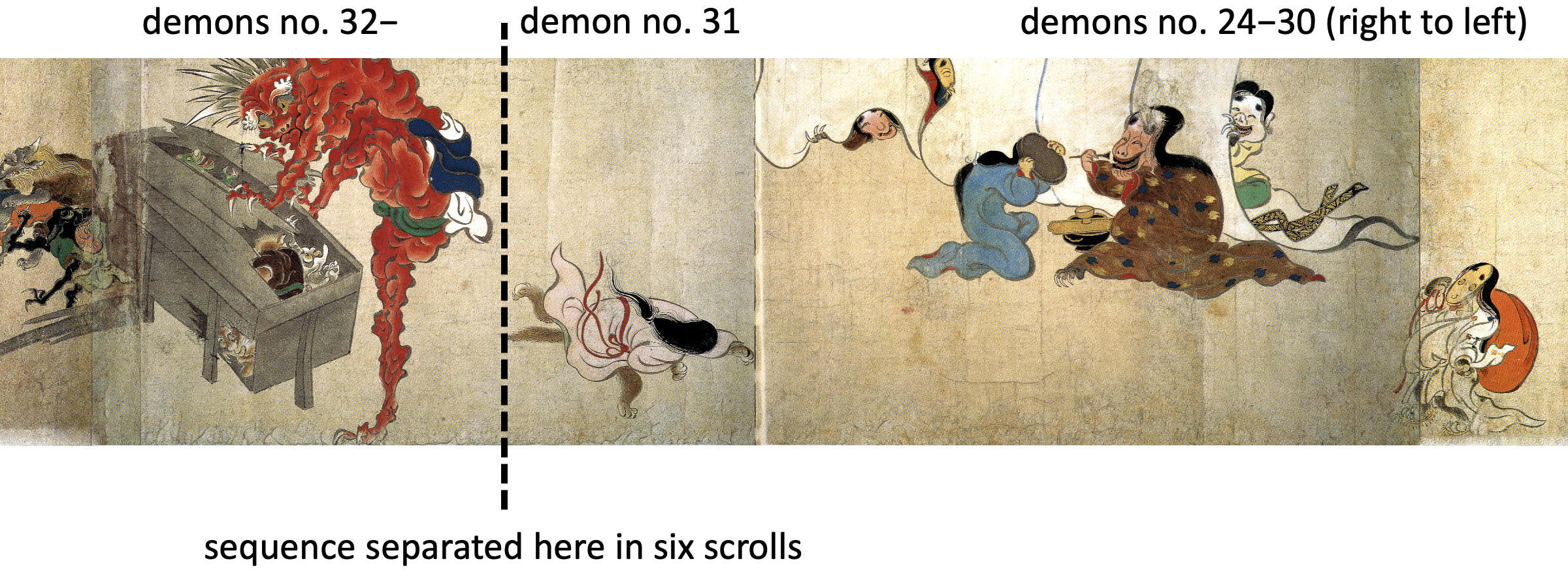
One of the common separated blocks of demon sequences in the class-A lineage annotated on the Shinjuan scroll [^tanaka1999].
5.3 Genealogy of the Class-AB/BA Lineage
Next, we will examine the ancestry of the class-AB/BA lineages. Class-AB comprises the combined scrolls that begin with Shinjuan demons followed by Nichibunken-A demons, and class-BA is the opposite. In terms of the arrangement of demons, class-AB/BA scrolls share a common characteristic. Near the end of the scrolls, there is a section where three demons from the class-B lineage are interwoven among class-A demons (Figure 11). Such shared characteristics would not exist if the prototypes for class-AB and class-BA scrolls were created independently by different painters at different times. Instead, it would be more natural to assume that class-AB/BA scrolls share a common ancestor and later copies followed this sequence as it appears in their ancestor scroll. The characteristics of class-AB/BA scrolls are summarized in Table 2.
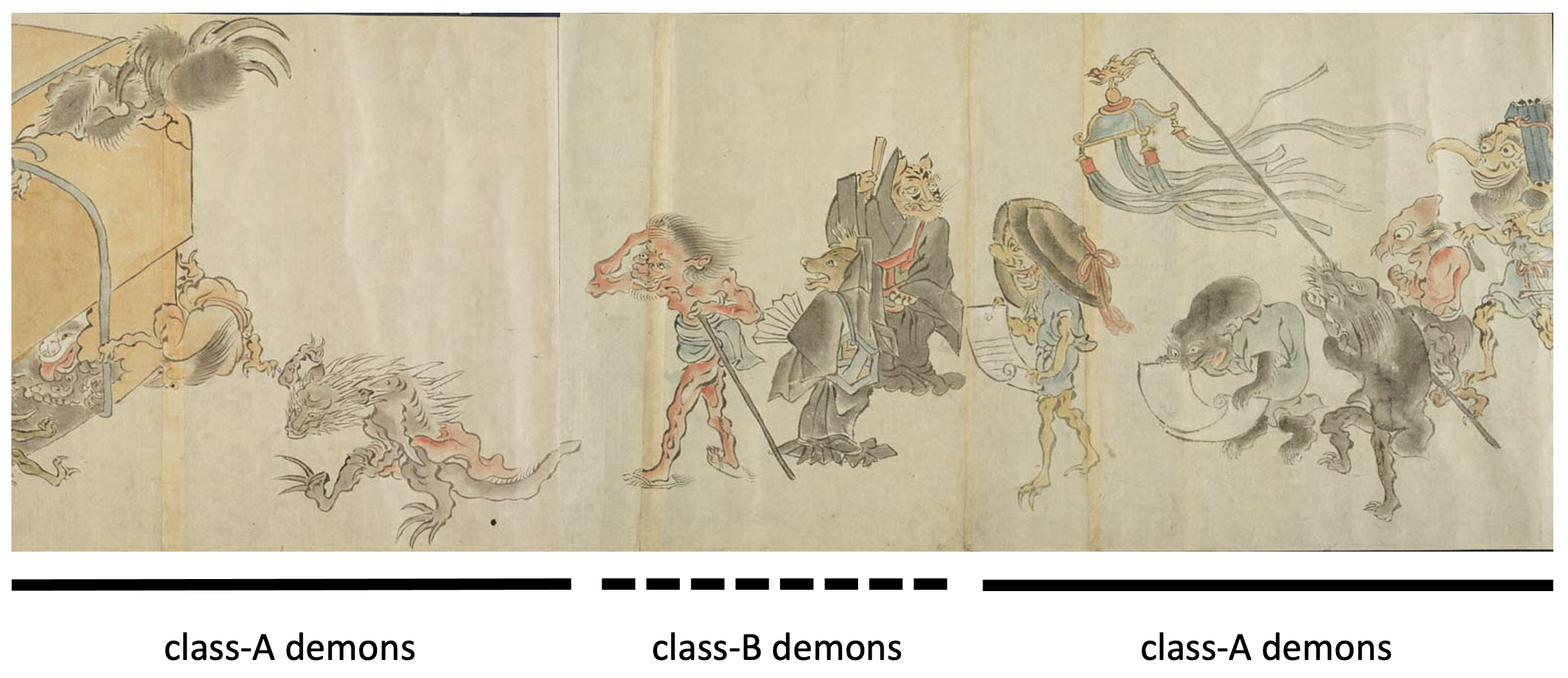
Shared sequence of class-AB/BA lineage scrolls (Tōhaku-A).
Characteristics of class-AB/BA scrolls. Class No. Scroll class-A Part class-B Part AB 35 Beatty Identical to Shinjuan (the first demon omitted) Many swaps and omissions 36 Kunaichō-A Many swaps and omissions Many swaps, deformations, and omissions 37 Rekihaku-C Identical to Shinjuan Most demons omitted leaving three BA 40 Geidai-A Identical to Shinjuan Many swaps and omissions 45 OHRM Partially swapped from Shinjuan Many swaps, deformations, and omissions 47 Rekihaku-B Identical to Tōhaku-A Many swaps, deformations, and omissions 49 Tōhaku-A Partially swapped from Shinjuan Many swaps, deformations, and omissions
At first glance, it is evident that the majority of demon configurations of the class-A part of the picture scroll are nearly identical to those of the Shinjuan scroll. In contrast, the demons in the class-B part contain more swaps, deformations, and omissions from the Nichibunken-A scroll. In the Kunaichō-A, OHRM, Rekihaku-B, and Tōhaku-A scrolls, a deformation refers to the change from demon with spear and hat to octopus head demon (Figure 12).

Demon with spear and hat and Octopus head demon (left: Nichibunken-A scroll; right: Tōhaku-A scroll).
Among the class-AB scrolls, the only scroll discussed in this paper is the Beatty scroll, which retains the arrangement of demons relatively well. On another front, this method make it possible to trace the genealogy of class-BA. Based on the edit distance among the class-BA scrolls (Table 3), the minimum spanning tree is depicted as a linear connection: Geidai-A to OHRM to Tōhaku-A to Rekihaku-B (or vice versa) with distances of two, two, and one, respectively. As in the case of class-A scrolls, this lineage tree must be evaluated based on qualitative characteristics. The four class-BA scrolls contain four peculiar depictions: a demon with a pot lid handle attached or not, a fleeing monkey wearing a hat or not, a spear-carrying demon with an octopus head or not, and a demon holding two leaves depicted or not (Table 4). Using these binary categorical data, Figure 13 is generated as a dendrogram. Dendrogram of four class-BA scrolls employing four characteristics of demon depiction (average linkage clustering and Euclid distance). The Tōhaku-A and Rekihaku-B scrolls share the same characteristics.
Edit distance between class-BA scrolls. Geidai-A OHRM Rekihaku-B Tōhaku-A Geidai-A 0 2 5 4 OHRM 0 3 2 Rekihaku-B 0 1 Tōhaku-A 0 The qualitative characteristics in class-AB (Beaty) and BA (others) scrolls. Scroll Pot Lid Handle Monkey with Hat Octopus Head Two Leaves Beatty ✓ ✓ Geidai-A ✓ ✓ OHRM ✓ Tōhaku-A ✓ ✓ ✓ Rekihaku-B ✓ ✓ ✓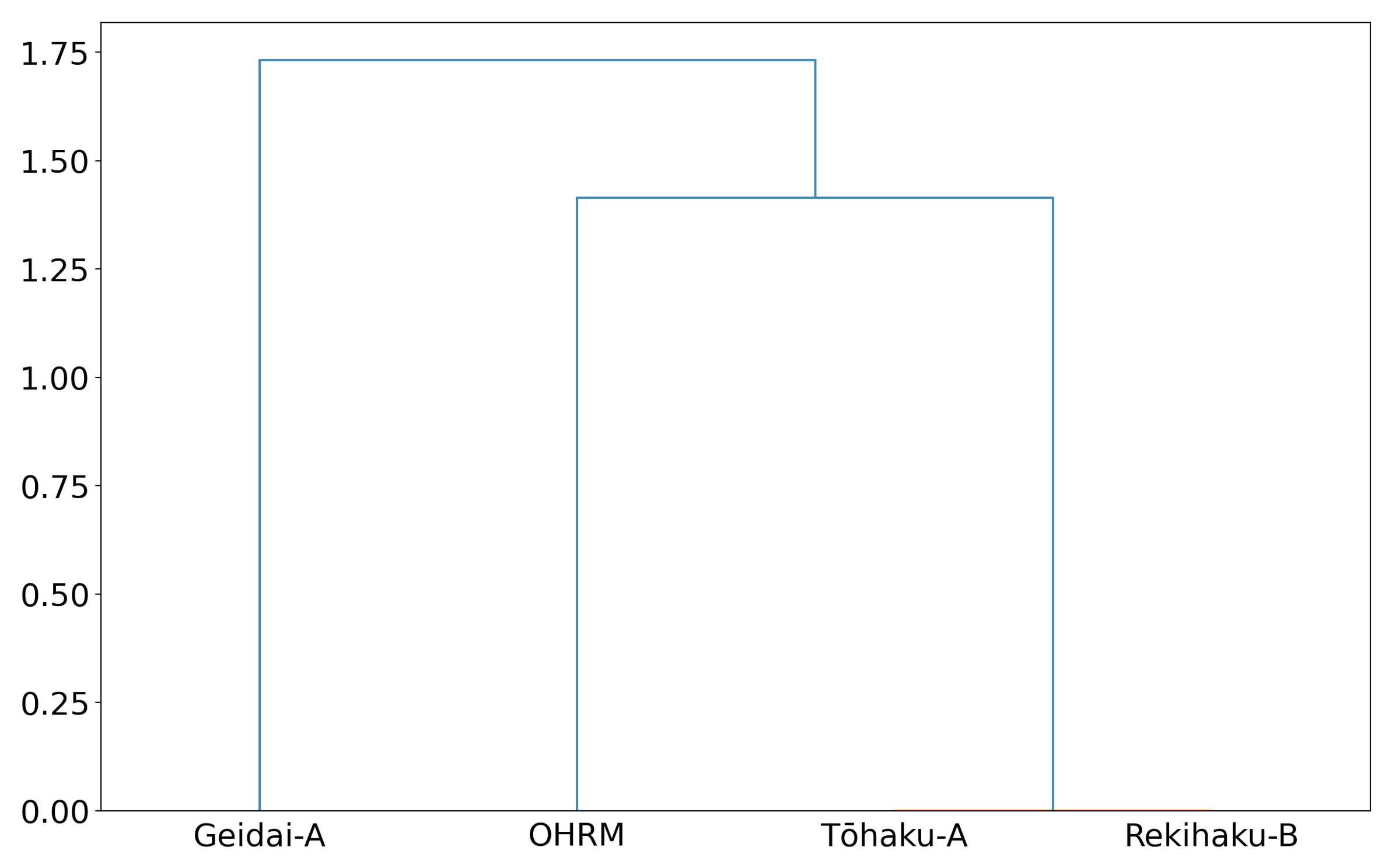
This dendrogram supports the premise that the root of the lineage tree is traceable to Geidai-A. As a result, the most straightforward iconographic transmission started from Geidai-A, which was inherited by OHRM, Tōhaku-A, and Rekihaku-B (Figure 14). First, the demon with two leaves motif was omitted from Geidai-A, creating a nested image for OHRM. The demon with a spear and hat appearing at the beginning of the scroll was transformed into a demon with an octopus head at this time.32 When the ancestor of the OHRM scroll was swapped by two blocks, the arrangement of Tōhaku-A was produced. A further one-block swap resulted in the Rekihaku-B arrangement. In addition to OHRM, the Tōhaku-A and Rekihaku-B scrolls also exclude the demon with two leaves motif and transform the demon with a spear and hat into an octopus head demon.
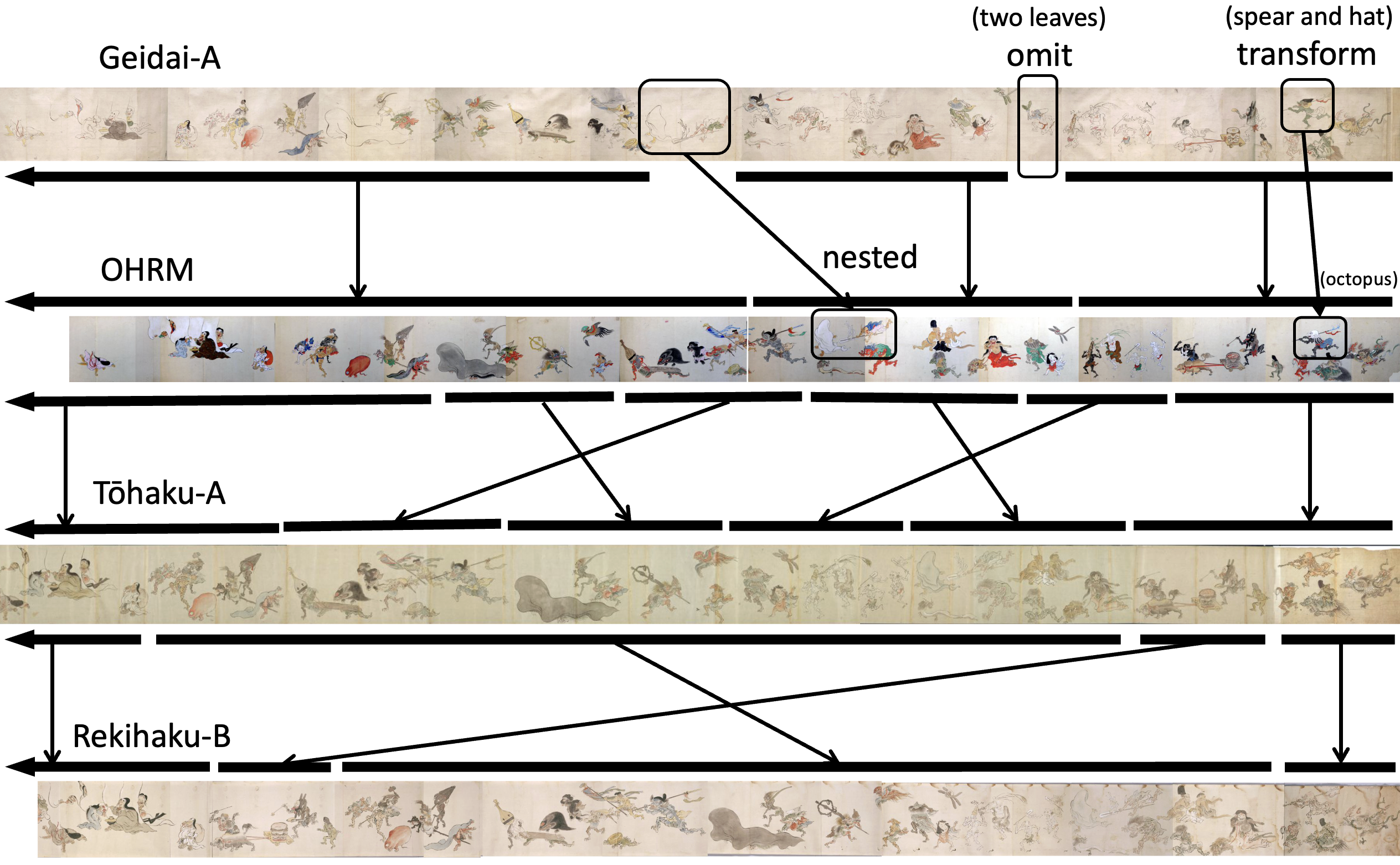
From Geidai-A to OHRM, Tōhaku-A, Rekihaku-B scrolls. The last parts of the scrolls have been abbreviated.
Based on the preceding, Figure 15 depicts the results of estimating the editing process of the class-AB/BA lineages. Initially, these classes were created relying upon prototypes of the Shinjuan and Nichibunken-A scrolls, but at some point the demon in a white robe motif was omitted. The Geidai-A scroll is the closest to the class-BA prototype. The OHRM scroll was created using Geidai-A’s ancestor as a template. In the process, the demon with a spear and a hat became an octopus head demon, and the demon with two leaves motif was omitted. The ancestors of Tōhaku-A and Rekihaku-B were born from the OHRM prototype.
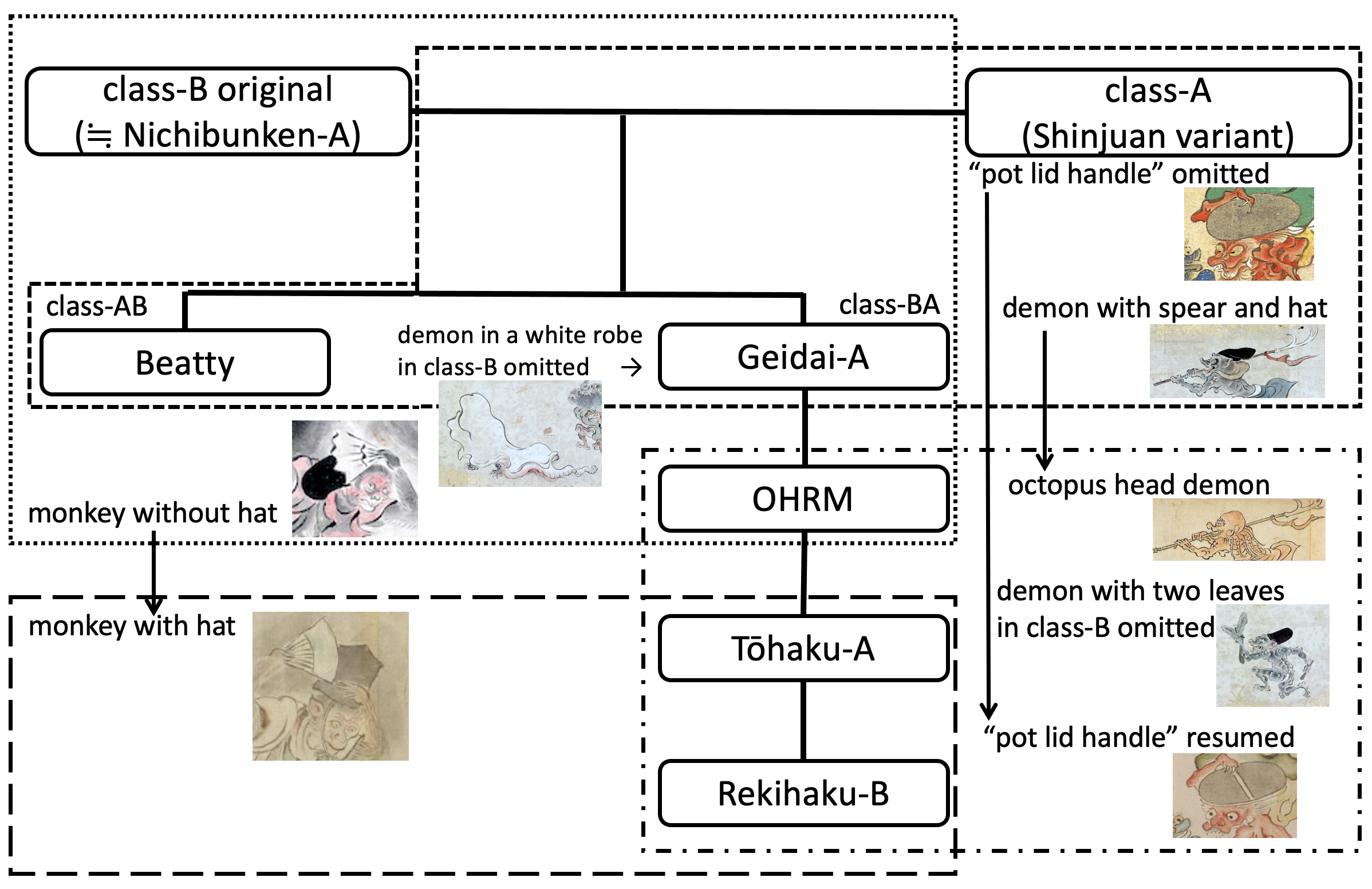
Estimation of the editing process of the class-AB/BA lineage. Each scroll name does not always refer to the scroll itself but also may indicate its prototype.
Let us apply two qualitative characteristics of the iconographic specifics to the results of this estimate. The first characteristic is the presence or absence of a pot lid handle in the previously mentioned class-A lineage, and the second is whether or not the fleeing monkey in the latter half of the class-B lineage is wearing a hat. As seen in the Nichibunken-B scroll, it can be assumed that the pot lid handle was originally a part of the class-A lineage, but that it was eliminated in the Shinjuan scroll. As in the Nichibunken-A scroll, the fleeing monkey would have been depicted without a hat in the class-B prototype. These two characteristics were passed along to the Beatty and Geidai-A scrolls. In contrast, a pot lid handle was added after the Geidai-A scroll was created, and the fleeing monkey was covered with a hat after the OHRM. These characteristics are shared by the Tōhaku-A and Rekihaku-B scrolls.
Estimating the Editing Process of Demons Scrolls
The editing processes of the class-AC and AD/DA lineages remain to be estimated. As for class-AC, Kyōgaen (No. 55 in the Appendix), Sendai (No. 56), Tōdai (No. 58), and Yumoto-F (No. 59) will be considered. It is difficult to determine the edit distance between these works, however, due to the numerous additions, deletions, and swaps of demons from the prototype. The arrangement of demons in the class-A lineage appears to be based not on the Shinjuan scroll but on Nichibunken-B in all of these materials. Consequently, the pot lid handle is depicted in all the class-AC scrolls that have survived. It was combined with the ancestor of KCUA to form the class-AC prototype, from which the draft of Kyōgaen (dated 1775) was created.
As for class-AD/DA scrolls, the characteristics are indicated in Table 5. Similar to class-AC, AD shares many characteristics with Nichibunken-B instead of the Shinjuan scroll. Rekisaikan-B and Spencer-C, which retain the arrangement of Nichibunken-B, appear to be the closest to the class-AD prototype.
Characteristics of class-AD/DA scrolls. Class No. Scroll class-A Part class-D Part AD 60 Ehime Unique arrangement Many additions, swaps, and omissions 64 Rekisaikan-B Identical to Nichibunken-B Many additions, swaps, and omissions 65 Rekihaku-D A part of Nichibunken-B Resembles Spencer-C 66 Spencer-C Identical to Shinjuan (the first to the third demons omitted) One demon swapped from Rekisaikan-B DA 69 Yamauchi Unique arrangement Identical to Spencer-C 70 Waseda-B Identical to NDL-A Identical to Spencer-C
As an example, we will describe how the demons in Rekisaikan-B are arranged. Although the sequence is split and copied, the demons are identical to those in the Nichibunken-B scroll; however, the editing of the demons from Hyogo-A is more complicated. Moreover, the class-D part of the Rekisaikan-B scroll contains two demons that are absent from Hyogo-A. This suggests that the demons within the Hyogo-A scroll may have been repeatedly swapped and eliminated during the copying process from the class-D prototype.
On the basis of the preceding argument, the class-AD/DA editing process can be estimated as follows: First, the class-A component of AD/DA scrolls is based on the prototype of Nichibunken-B. The initial class-AD/DA scrolls were created from this and the ancestor of Hyogo-A. However, after the creation of the prototypes, it is difficult to ascertain the genealogies of this lineage. The pot lid handle is not depicted in existing class-AD/DA scrolls. Since the prototype of class-A appears to have possessed the pot lid handle motif as exemplified in Nichibunken-B, it was likely eliminated around the time the ancestors of these scrolls were painted. If this is the case, class-AD/DA scrolls which include the pot lid handles could be the missing link in this lineage.
Finally, let us summarize the estimation of the editing processes of Demons Scroll lineages (Figure 16). The most important point is that among the various scrolls in the class-A lineage, the compositional arrangement of demons in Nichibunken-B is older than that of the most famous Shinjuan scroll. In addition, the author argues that the arrangement of demons in the present-day Shinjuan scroll was created through the misordering of its paper sheets. In class-AB/BA scrolls, the arrangement seen in Nichibunken-A was combined with that of the current Shinjuan scroll, whereas class-AC and AD/DA scrolls are assumed to have combined motifs from the ancestor of Nichibunken-B, instead of the Shinjuan scroll. Since Kyōgaen, a class-AC printed book, has a colophon dated 1775, the original class-AC lineage must have been established prior to that year.
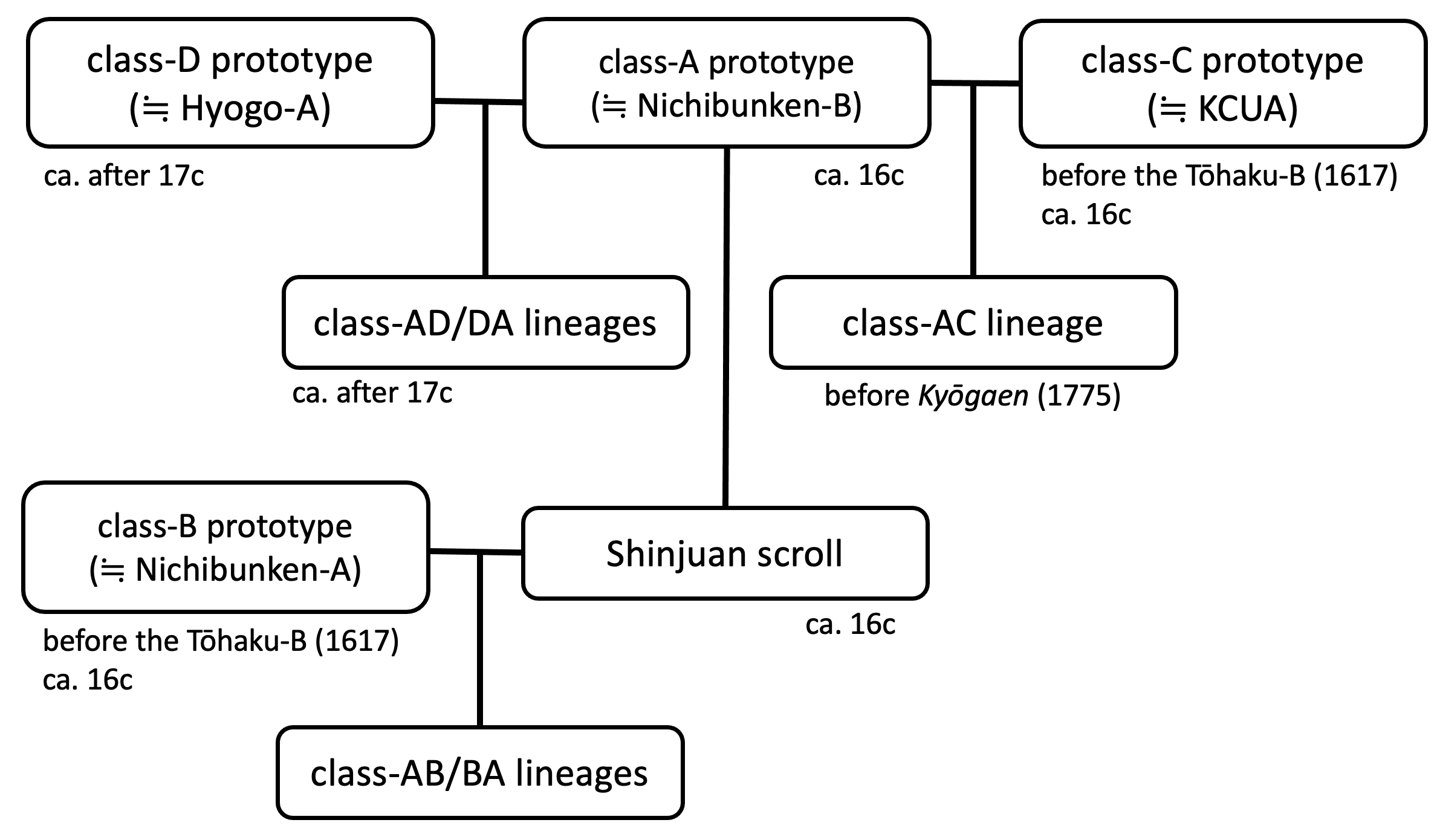
Estimation of the editing process of Demons Scroll lineages.
The other datable artifact is Tōhaku-B, a scroll of class-BC that was not examined in detail for this paper. Tōhaku-B contains demons from the KCUA scroll mixed with those from Nichibunken-A (the majority of which are inverted), as well as demons not found in either scroll. It is dated 1617, so it is likely that both the Nichibunken-A and KCUA scrolls were painted prior to that year. Based on the clothing and customs depicted in the scrolls, some scholars believe that their prototypes were painted in the sixteenth century. Since the Shinjuan scroll is also said to have been created in the sixteenth century, the prototype for Nichibunken-B must have been made around or prior to that time. On the other hand, since it is believed that the original Hyogo-A scroll was created during the Edo period (1603–1868), it can be assumed that the class-AD/DA lineages evolved during the same time frame or later.
6. Conclusion
The above-mentioned estimates are the result of using a digital humanities approach to study Demons Scrolls, focusing on the configuration of demons. The fact that we were able to deduce and reconstruct the rational editing process from the surviving scrolls provides additional support for the mixture theory of Demons Scrolls. However, there is one flaw in this paper’s methodology. If the differences in arrangement are the result of changes in the order of the paper sheets occurring in later periods, the conclusion may be affected. Although scrolls with a high probability of misordered paper sheets were excluded from this study in advance, if a disorder is discovered in other scrolls, it will be necessary to reconsider our findings. However, if we consider this kind of disorder to be the result of editing by someone other than the painter, it may not be necessary to exclude all disordered scrolls.
To further strengthen the mixture theory of Demons Scrolls, two additional riddles must be solved. First, if there are four distinct lineages, why are the surviving non-class-A scrolls so few in number? There are at least twenty-seven copies in the class-A lineage, but only two in class-B and class-D, and three in the class-C lineages. Second, why are all the demons in the combined scrolls from the class-A lineage? If there were four distinct lineages, one would expect to find a greater number of combined scrolls from lineages other than class-A. The only exception to this rule is Tōhaku-B (class-BC, No. 71 in the Appendix); the absence of class-BD and CD scrolls is also a mystery. This may be due to the preferences of the group of painters who replicated the Demons Scroll and/or their patrons. We defer clarification of this point to future art historical research.
This digital humanities research methodology is applicable to other types of undated materials in which the separable unit in the content is ordered sequentially and there are multiple versions in which the unit is swapped, omitted, or a new unit is inserted. To name a few examples: handwritten catalogs of Japanese martial arts, other picture scrolls of which multiple copies were produced, and even drafts of novels. To broaden the potential application of this method, mutual understanding and increased collaborations between the digital humanities and other disciplines are essential.
Acknowledgements
This paper is based on an article originally published in Japanese 33. The author added new data, corrected errors, updated the discussion, and edited the manuscript for an Anglophone audience. This research utilized digital images collected by the Database Project for Cultural Materials on Monsters and Specters directed by Komatsu Kazuhiko at the International Research Center for Japanese Studies (Nichibunken).
Appendix
Class No. Name (tentative) Owner Format Official Resource Target Note A (Shinjuan lineage) 1 Sinjuan Shinjuan sub-temple, Daitokuji temple Hand scroll ✓ 2 Appendix for _ Kaidan meisakush ū _ Unknown Hand scroll Identical to Rekisaikan-A 3 Boston Museum of Fine Arts, USA Hanging scroll Hanging scroll format 4 Gakushuin Gakushuin University Hand scroll One demon dropped; almost identical to Nichibunken-B 5 Guimet Guimet Museum, France Hand scroll First half missing; identical to Itō and Nichibunken-B 6 Gunma Gunma University Hand scroll Whole picture is unknown 7 Itō Itō Mitsunori Hand scroll ✓ Attributed to Kanō Morifusa, ca. 1688–1707 8 Iwase Iwase Bunko Library Hand scroll Unique arrangement; demons added from “Bakemono zukushi” 9 Iwate Iwate Prefectural Museum Hand scroll ✓ 10 Kōdaiji Kōdaiji temple Hand scroll First half missing; identical to Itō and Nichibunken-B 11 Krakow Museum of Japanese Art and Technology, Poland Hand scroll Second half missing 12 NDL-A National Diet Library Hand scroll [https://dl.ndl.go.jp/info:ndljp/pid/2541003](https://dl.ndl.go.jp/info:ndljp/pid/2541003) ✓ 13 NDL-B National Diet Library Hand scroll [https://dl.ndl.go.jp/info:ndljp/pid/2540972](https://dl.ndl.go.jp/info:ndljp/pid/2540972) With description, demons significantly omitted and swapped; dated 1316 but dubious 14 Nichibunken-B International Research Center for Japanese Studies (Nichibunken) Hand scroll [https://toshonin.nichibun.ac.jp/webopac/TW92059016](https://toshonin.nichibun.ac.jp/webopac/TW92059016) ✓ 15 Nichibunken-C International Research Center for Japanese Studies (Nichibunken) Hand scroll [https://toshonin.nichibun.ac.jp/webopac/BB10030852](https://toshonin.nichibun.ac.jp/webopac/BB10030852) ✓ 16 OCM Osaka City Museum of Fine Arts Hand scroll Disorder suspected 17 Okura-A Okura Museum of Art Screen Screen format 18 Rekihaku-A National Museum of Japanese History (Rekihaku) Hand scroll [https://www.rekihaku.ac.jp/database/syuz/F-320-3](https://www.rekihaku.ac.jp/database/syuz/F-320-3) ✓ 19 Rekihaku-E National Museum of Japanese History (Rekihaku) Hand scroll [https://www.rekihaku.ac.jp/database/syuz/F-320-705](https://www.rekihaku.ac.jp/database/syuz/F-320-705) Identical to Iwase; dated 1684 20 Rekisaikan-A Kyoto Institute, Library and Archives (Rekisaikan) Hand scroll [http://www.archives.kyoto.jp/websearchpe/detail?cls=152_old_books_catalog&pkey=0000000115](http://www.archives.kyoto.jp/websearchpe/detail?cls=152_old_books_catalog&pkey=0000000115) Identical to NDL-A 21 Rikkyo Rikkyo University Hand scroll ✓ 22 Saiku Saiku Historical Museum Hand scroll Identical to Shinjuan 23 Spencer-B New York Public Library, USA Hand scroll ✓ With description, two demons are duplicated 24 Tōhaku-C Tokyo National Museum (Tōhaku) Hand scroll [https://colbase.nich.go.jp/collection_items/tnm/A-3169?locale=ja](https://colbase.nich.go.jp/collection_items/tnm/A-3169?locale=ja) Identical to Nichibunken-B 25 Waseda-A Waseda University Hand scroll [https://archive.wul.waseda.ac.jp/kosho/wa03/wa03_03645/wa03_03645_0404/](https://archive.wul.waseda.ac.jp/kosho/wa03/wa03_03645/wa03_03645_0404/) First demon omitted from Shinjuan 26 Yumoto-A Yumoto Kōichi Hand scroll Identical to Nichibunken-B 27 Yumoto-B Yumoto Kōichi Hand scroll Identical to Iwase B (Nichibuken-A lineage) 28 Nichibunken-A International Research Center for Japanese Studies (Nichibunken) Hand scroll [https://toshonin.nichibun.ac.jp/webopac/BB10030851](https://toshonin.nichibun.ac.jp/webopac/BB10030851) ✓ 29 Yumoto-C Yumoto Kōichi Hand scroll A part of Nichibunken-A C (KCUA lineage) 30 KCUA Kyoto City University of Arts Hand scroll ✓ 31 Okura-B Okura Museum of Art Hand scroll Demons significantly omitted; one demon added 32 Tokushima Tokushima Prefectural Museum Hand scroll Demons omitted and added D (Hyogo lineage) 33 Hyogo-A Hyogo Prefectural Museum of History Hand scroll [https://rekihaku.pref.hyogo.lg.jp/en/digital_museum/ebanashi/sakuhin/ka0014/](https://rekihaku.pref.hyogo.lg.jp/en/digital_museum/ebanashi/sakuhin/ka0014/) ✓ 34 Illustration in _ Kaidan meisakush ū _ Unknown Hand scroll Whole picture is unknown AB (Shinjuan + Nichibuken-A) 35 Beatty Chester Beatty Library, Ireland Hand scroll ✓ 36 Kunaichō-A Imperial Household Agency (Kunaich ō) Hand scroll ✓ 37 Rekihaku-C National Museum of Japanese History (Rekihaku) Hand scroll [https://www.rekihaku.ac.jp/database/syuz/F-320-4-93](https://www.rekihaku.ac.jp/database/syuz/F-320-4-93) ✓ Dated 1822 38 Yuishōji Yuishōji temple Hand scroll Whole picture is unknown 39 Yumoto-E Yumoto Kōichi Hand scroll Whole picture is unknown BA (Nichibunken-A + Shinjuan) 40 Geidai-A Tokyo University of the Arts (Geidai) Hand scroll [http://jmapps.ne.jp/geidai/det.html?data_id=19506](http://jmapps.ne.jp/geidai/det.html?data_id=19506) ✓ 41 Hyogo-B Hyogo Prefectural Museum of History Hand scroll [https://rekihaku.pref.hyogo.lg.jp/en/digital_museum/ebanashi/sakuhin/ka0014/](https://rekihaku.pref.hyogo.lg.jp/en/digital_museum/ebanashi/sakuhin/ka0014/) Identical to Tōhaku-A 42 Kousanji Kousanji Museum Hand scroll Demons significantly mirrored and swapped 43 Kumon Kumon Institute of Education Hand scroll Identical to Tōhaku-A 44 Kunaichō-B Imperial Household Agency (Kunaich ō) Hand scroll Whole picture is unknown 45 OHRM Osaka Human Rights Museum Hand scroll ✓ 46 Pushkin Pushkin State Museum of Fine Arts, Russia Hand scroll Whole picture is unknown; identical to Geidai-A 47 Rekihaku-B National Museum of Japanese History (Rekihaku) Hand scroll [https://www.rekihaku.ac.jp/database/syuz/F-320-213](https://www.rekihaku.ac.jp/database/syuz/F-320-213) ✓ 48 Sanada The Sanada Treasures Museum Hand scroll [http://jmapps.ne.jp/sndhmt/det.html?data_id=5718](http://jmapps.ne.jp/sndhmt/det.html?data_id=5718) Identical to Tōhaku-copy 49 Tōhaku-A Tokyo National Museum (Tōhaku) Hand scroll [https://webarchives.tnm.jp/imgsearch/show/C0056370](https://webarchives.tnm.jp/imgsearch/show/C0056370) ✓ 50 Tohoku Tohoku University Hand scroll [https://www.i-repository.net/il/meta_pub/G0000398tuldc_1100016310](https://www.i-repository.net/il/meta_pub/G0000398tuldc_1100016310) Identical to Tōhaku-A 51 Yumoto-D Yumoto Kōichi Hand scroll Demons significantly omitted AC (Shinjuan + KCUA) 52 Burke The Burke Foundation, USA Hand scroll Identical to _ Kyōgaen _ 53 Konpira-A Kotohiragū shrine Hand scroll Identical to _ Kyōgaen _ 54 Konpira-B Kotohiragū shrine Hand scroll Identical to _ Kyōgaen _ 55 _ Kyōgaen _ Kawasaki City Museum etc. Printed book [http://kawasaki.iri-project.org/content/?doi=0447544/01800000GK](http://kawasaki.iri-project.org/content/?doi=0447544/01800000GK) ✓ Dated 1775 56 Sendai Sendai City Museum Hand scroll ✓ 57 Spencer-A New York Public Library, USA Hand scroll Disorder suspected 58 Tōdai Tokyo University (Tōdai) Hand scroll [https://da.dl.itc.u-tokyo.ac.jp/portal/assets/fbd0479b-dbb4-4eaa-95b8-f27e1c423e4b](https://da.dl.itc.u-tokyo.ac.jp/portal/assets/fbd0479b-dbb4-4eaa-95b8-f27e1c423e4b) ✓ 59 Yumoto-F Yumoto Kōichi Hand scroll ✓ AD (Shinjuan + Hyoga-A) 60 Ehime Museum of Ehime History and Culture Hand scroll [https://ehime-archive.iri-project.org/detail/ps-0011](https://ehime-archive.iri-project.org/detail/ps-0011) ✓ 61 Geidai-B Tokyo University of the Arts (Geidai) Hand scroll [http://jmapps.ne.jp/geidai/det.html?data_id=32299](http://jmapps.ne.jp/geidai/det.html?data_id=32299) Identical to Rekisaikan-B 62 Kyōgoku Kyōgoku Natsuhiko Hand scroll Whole picture is unknown 63 Nichibunken-D International Research Center for Japanese Studies (Nichibunken) Hand scroll [https://toshonin.nichibun.ac.jp/webopac/BB10059786](https://toshonin.nichibun.ac.jp/webopac/BB10059786) Demons significantly swapped 64 Rekisaikan-B Kyoto Institute, Library and Archives (Rekisaikan) / The Museum of Kyoto Hand scroll ✓ 65 Rekihaku-D National Museum of Japanese History (Rekihaku) Hand scroll [https://www.rekihaku.ac.jp/database/syuz/F-320-532](https://www.rekihaku.ac.jp/database/syuz/F-320-532) ✓ 66 Spencer-C New York Public Library, USA Hand scroll ✓ 67 Yumoto-G Yumoto Kōichi Hand scroll Whole picture is unknown DA (Hyoga-A + Shinjuan) 68 Mononobe Mononobe jinja shrine Hand scroll Demons significantly swapped 69 Yamauchi Tosa Yamauchi Family Treasury and Archives Hand scroll ✓ 70 Waseda-B Waseda University Hand scroll [https://archive.wul.waseda.ac.jp/kosho/chi04/chi04_01059/](https://archive.wul.waseda.ac.jp/kosho/chi04/chi04_01059/) ✓ BC (Nichibuken-A + KCUA + ɑ) 71 Tōhaku-B Tokyo National Museum (Tōhaku) Hand scroll [https://webarchives.tnm.jp/imgsearch/show/C0043198](https://webarchives.tnm.jp/imgsearch/show/C0043198) Demons significantly omitted and inverted; dated 1617
Flanders, J., Piez, W. and Terras, M. (2007) “Welcome to Digital Humanities Quarterly ” , Digital Humanities Quarterly , 1(1). http://www.digitalhumanities.org/dhq/vol/1/1/000007/000007.html. ↩︎
Flanders, J. (2009) “The productive unease of 21st-century digital scholarship” , Digital Humanities Quarterly , 3(2). http://www.digitalhumanities.org/dhq/vol/3/3/000055/000055.html. ↩︎
Lang, S. and Ommer, B. (2021) “Transforming information into knowledge: How computational methods reshape art history” , Digital Humanities Quarterly , 15(3). http://www.digitalhumanities.org/dhq/vol/15/3/000560/000560.html. ↩︎
“ Hyakki Yagyō Emaki ” are a genre of handscroll paintings that illustrate a nocturnal parade of demons and spirits. These scrolls depict a variety of supernatural figures associated with musical instruments, Buddhist ritual objects, household implements, and other mundane objects awakening and marching under the cover of night. The significance of these motifs remains enigmatic, and art historians have debated how to interpret these works. This type of picture scroll was frequently reproduced during the premodern period and widely disseminated. Since Japanese kanji characters do not have fixed pronunciations, the romanization cannot always be determined. In the majority of instances, historians and cultural anthropologists read the characters as Hyakki Yagyō, whereas literature scholars prefer Hyakki Yakō. ↩︎
For further information on Japanese yōkai culture, see 34, 35, and 36. ↩︎
In many cases of premodern artworks in Japan, one work is copied by another artist, and that work is then copied by another. The same practice can be observed in the Demons Scrolls. In this paper, a lineage refers to this kind of linear connection of copied works. ↩︎
Japanese names are rendered according to the traditional order (last name comes first). ↩︎
Prior studies include 30, 28, 38, 39, 40, 41, 42, 43, 44, and 45. ↩︎
Tanaka, T. (2002) Hyakki yakō no mieru toshi . Tokyo: Chikuma Gakugei Bunko. ↩︎
Yumoto, K. (2005) Hyakki yagyō emaki: Yōkaitachi ga sawagidasu . Tokyo: Shogakukan. ↩︎ ↩︎
Komatsu, K. (2008) Hyakki yagyō emaki no nazo . Tokyo: Shuisha Shinsho. ↩︎ ↩︎ ↩︎ ↩︎
Yano, T. (1999) Kundaikansōchōki no sōgō kenkyū . Tokyo: Bensei Shuppan. ↩︎
Yano, T. (2022) “Rikū hyakkaiki no naiyō to Keitōgakuteki kentō” , Chasho Kenkyū , 11, pp. 88–100. ↩︎
Yano, T. (2006) “Buka keitōgaku: Rekishi o fukugensuru” , in Murakammi, M. (ed.) Bunka jōhōgaku nyūmon . Tokyo: Bensei Shuppan, pp. 36-48. ↩︎
Available at: https://uni-tuebingen.de/en/fakultaeten/mathematisch-naturwissenschaftliche-fakultaet/fachbereiche/informatik/lehrstuehle/algorithms-in-bioinformatics/software/splitstree/. ↩︎
Hayashi’s Quantification Theory was developed by Hayashi Chikio during late 1940s to 50s and widely used in Japan. Its Family III is mathematically equivalent to Correspondence Analysis. ↩︎
Nerbonne, J. (2005) “Computing contributions to the humanities” , Literary and Linguistic Computing , 20(1), pp. 25–40. https://doi.org/10.1093/llc/fqh041. ↩︎
The edit distance is a metric for evaluating the dissimilarity between two strings. It quantifies the number of operations (e.g. insertions, deletions, and substitutions) necessary to convert one string into another. This metric is widely utilized in computer science and linguistics to assess the similarity of two strings. ↩︎
Hämääinen, M. et al (2018) “Normalizing early English letters to present-day English spelling” , Proceedings of the Second Joint SIGHUM Workshop on Computational Linguistics for Cultural Heritage, Social Sciences, Humanities and Literature , pp. 87–96. Available at: https://aclanthology.org/W18-4510 ↩︎
Benito-Santos, A., Díaz, A. R. and Sánchez, R. T. (2019) “Exposing uncertainty on the historical name normalization task” , Proceedings of the Seventh International Conference on Technological Ecosystem for Enhancing Multiculturality , pp. 795–803. https://doi.org/10.1145/3362789.3362920. ↩︎
Bernholz, C. D. and Zillig, B. L. P. (2011) “Comparing nearly identical treaty texts: A note on the Treaty of Fort Laramie with Sioux, etc., 1851 and Levenshtein’s edit distance metric” , Literary and Linguistic Computing , 26(1), pp. 5–16. https://doi.org/10.1093/llc/fqq016. ↩︎
Hyytiäinen, P. (2022) “A new method in establishing quantitative relationships between manuscripts of the New testament ” , Digital Scholarship in the Humanities, 38(1), pp. 151–166. https://doi.org/10.1093/llc/fqac030 ↩︎
Baker, J., Salway, A. and Roman, C. (2022) “Detecting and characterising transmission from legacy collection catalogues” , Digital Humanities Quarterly , 16(2). http://digitalhumanities.org:8081/dhq/vol/16/2/000615/000615.html. ↩︎
Japanese picture scrolls are comprised of several sheets of paper which are joined together to form a continuous horizontal format. The individual sheets are detachable and can be easily rejoined, so disorder may occur after the series of sheets are separated. ↩︎
There are numerous scrolls with Hyakki Yagyō or similar terms in their titles, but we omitted them if the majority of demons depicted are not from these four lineages. ↩︎
The Yumoto-A scroll is in fact a more detailed copy than Nichibunken-B. Nevertheless, we chose the latter because it is undeniably an older scroll. The NDL-B (No. 12 in the Appendix) and Spencer-B scrolls both contain written accounts of each scene that are identical. The Tōhaku-B (No. 71) and Spencer-B scrolls are rare cases where the names of demons are included. ↩︎
Komatsu, S. (1979) “ “Hyakki yagyō emaki” no nazo” , in Komatsu, S. (ed.) Nihon emaki taisei 25: Nōe hōshi ekotoba; Fukutomi zōshi; Hyakki yagyō emaki . Tokyo: Chokoronsha, pp. 126–141. ↩︎ ↩︎
Tooth blackening (ohaguro) was a Japanese cosmetic treatment used primarily by married women to darken their teeth. ↩︎
Komatsu, S. (1979) “Zuhan hyakki yagyō emaki” , in Komatsu, S. (ed.) Nihon emaki taisei 25: Nōe hōshi ekotoba; Fukutomi zōshi; Hyakki yagyō emaki . Tokyo: Chokoronsha, pp. 69–91. ↩︎ ↩︎
Yasumura, T. (1987) “ Egakareta yōkai: Hyakki yagyō emaki” , in Yasumura, T. (ed.) Bessatsu taiyō 57: Nihon no yōkai . Tokyo: Heibonsha, pp. 39–49. ↩︎
Similar transformation is indicated in Figure 12. ↩︎
Yamado, S. (2009) “ “Hyakko yagyō emaki” henshū no keifu: Jōhōgaku kara no kaimei” , Nihon Kenkyū , 40, pp. 103–128. http://doi.org/10.15055/00000512 ↩︎
Foster, M. D. (2009) Pandemonium and parade: Japanese monsters and the culture of yōkai . Oakland: University of California Press. ↩︎
Foster, M. D. (2015) The book of yōkai: Mysterious creatures of Japanese folklore . Oakland: University of California Press. ↩︎
Komatsu, K. (2018) Introduction to yōkai culture: Monsters, ghosts, and outsiders in Japanese history . Tokyo: Shuppan Bunka Shinkō Zaidan. ↩︎
Cox, R. (ed.) (2007) The culture of copying in Japan: Critical and historical perspectives . London: Routledge. ↩︎
Komine, K. (1997) “Supensā-bon “Hyakki yakō emaki” ni tsuite: Kotobagaki o Chūshin ni” , Chūsei Bugaku Kenkyū, 23, pp. 69–79. ↩︎
Kobayashi, N. (1997) “Morifusa hitsu hyakki yagyō emaki” , Dearute , 13, pp. 18–41. ↩︎
Kawaguchi, E. (2002) “Hyakki yakō emaki o yomu” , Fuji jyoshi daigaku kokoubungaku zasshi, 67, pp. 77–92. ↩︎
Koga, H. (2006) “Kokuritsu kokkai toshokan zō Hyakki yakō emaki (kotobagaki tsuki) ni tsuite” , Buken tankyū , 44, pp. 1–12. https://doi.org/10.15017/8950 ↩︎
Tokeshi, N. (2007) _ “Hyakki yakō emaki” (Shinjyuan-bon) wa nani o arawashite irunoka_ , Sōsui , 8, pp. 23–43. ↩︎
Tsuji, E. (2012) “Supensā korekushon shozō “Hyakki yakō emaki” ni tsuite” , Nihon bungaku ronkyū, 71, pp. 22–31. ↩︎
Nagura, S. (2020) Shinjuan-bon Hyakki yagyō emaki kenkyū: Bukkyō o matou yō . PhD thesis. Aichi Prefectural University. Available at: http://doi.org/10.15088/00004335. ↩︎
Yanagisawa, E. (2020) “Hitachi-koku shimodate-han karō maki-ke kyūzō no “Hyakki yagyō emaki” ni tsuite” , Gakushuin daigaku shiryōkan kiyō , 26, pp. 1–7. ↩︎